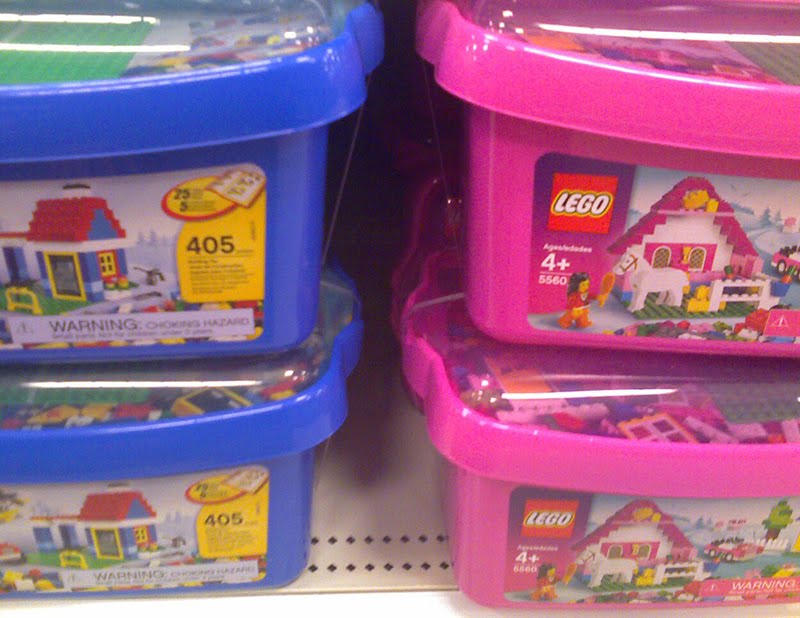 Some years ago when I taught a class in Human Growth and Development, there were five requirements for the students which involved paying attention to people at different stages of their lives. One of the class requirements was to go to a large department or big-box store, look at the toy aisles, and report on what they saw.
Some years ago when I taught a class in Human Growth and Development, there were five requirements for the students which involved paying attention to people at different stages of their lives. One of the class requirements was to go to a large department or big-box store, look at the toy aisles, and report on what they saw.
If you do the same thing, you know what you will find – a pink aisle full of dolls, dress-up materials, craft kits, and other toys designed for girls. The packaging will be primarily pink or purple and there is no question who the toys are intended to amuse. You will also find the corresponding blue aisle, which may also have toys in camouflage or other boy-appropriate packaging, which includes sports equipment, cars, or building toys. Depending on the season, there will be an aisle for more gender-neutral toys such as those for use in swimming pools or sliding down snowy hills, but even those toys will likely be packaged to appeal to either girls or boys. My students, by the way, having been in such stores many times before, were almost always astounded by the gendered nature of the toy department.
Recently, the big-box store Target announced that they will decorate their toy aisles in a more gender-neutral fashion and will no longer have signs that indicate that certain toys are for one group of children or another. While that may change the way that the toys are displayed, it is unlikely that the toy manufacturers are going to change the packaging. Simply displaying all the dolls together is likely to create a pink area in the toy department even if the entire aisle has other sorts of toys on the shelves. The concern is that creating the gendered toy aisles sends a message to children that some toys are appropriate for them and others are not therefore limiting the experiences that children might enjoy.
This amuses me because of the assumption that children’s notion of their gender is based entirely on how they are treated by others and what they encounter in their environment. This is based on the theory of “The Blank Slate” which states that we are the result of our experiences and that what comes with us when we are born has little or no impact on the person we become. Research is clear that isn’t true and that actually at least 50% and probably more of who we are is based on our genetics.
Gerriane Alexander, of Texas A & M University, has done a great deal of research in this area. What she discovered was that children, given free access to a wide variety of toys, will generally select toys that conform to the child’s own sex. A study from 2012 (Alexander and Saenz)1 revealed that for 19-month old children, there were very pronounced differences in voluntary engagement with toys and those differences conformed to the children’s gender. Little girls were significantly more likely to choose female-typical toys to play with. Little boys were less specific in their toy selection, but did often pick toys designed for them.
While it is a good thing for Target to reduce the gender specificity of their toy marketing, it is not really going to change the selection of toys for most children. Where it will make a difference is for the children who are interested in toys which are not typical for their gender. I myself was not interested in playing with dolls and was more fascinated by my brother’s Erector set (a metal building toy which was supplanted by Legos). It never occurred to me that my toy choice was inappropriate because I wasn’t subjected to the aggressive marketing strategies of the major toy manufacturers. I grew up in the country and we didn’t have a TV until I was 12 years old. By that time, my lack of interest in Barbie and other female oriented toys didn’t really matter to me as I had moved on to books and sports. Today, a girl who is interested in pursuits which are more typically associated with boys may have a hard time as she could easily get the impression that there is something wrong with her. Boys who are more attracted to female-typical interests can be treated as if there is something wrong with them. My son’s interest in tap dancing got him negative attention from his male classmates until they realized in 4th grade that the girls thought that boys who danced were cool. Then some wanted to join his dance class!
What makes us believe that we are male or female? That is a question whose answer has yet to be discovered. However, it is not based totally in either our genes or in how we were raised. Our sense of our gender is most certainly a combination of the two. Denying that children may be more interested in one type of toy or in a certain activity will not create a gender neutral society – that simply cannot happen. What we want is for children to be comfortable in their identity no matter what it is and making sure that all children have access to a wide variety of interests will help them grow up heathy and happy.
